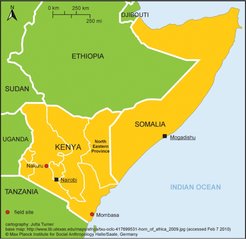Placemaking: Somali migrants in Kenyan cities
After the breakdown of the political system of Siad Barre in 1991 around 400.000 people from Somalia fled to Kenya. While the Kenyan government tried to contain these migrants in camps, the biggest one in Dadaab is now home to around 450.000 refugees from Somalia, many people prefered to settle outside the camps either in the Somali parts of Kenya in North Eastern Province or in Kenyan cities like Nairobi, Mombasa or Nakuru. Up to 100.000 refugees from Somali live, very often illegally, in these urban centres. Simultaneous to the migration of people from Somalia to the cities, Kenyan Somalis from North Eastern Province also moved into the urban centres. In the years following the initial migration movement to the cities many conflicts evolved between local communities and Somali migrants. In the course of these tensions Somalis are often indistinctively depicted as Muslim fundamentalists, who are responsible for a radicalisation of Islam in Kenya and the spread of terror from Somalia to the neighbouring countries, and/or as ruthless businessmen, who are using pirate money to get control over the Kenyan economy. This research project aims to question these assumptions by asking what specific impact the migration of Somalis to Kenyan cities since the early 1990s had on the local communities.

Nakuru, the main field site, is a city in the Rift valley with approximately 350.000 inhabitants. It is situated around 2 h by car in the West of Nairobi. The Somali population in Nakuru is of course smaller than in the now famous ‚Somali’ area in Nairobi, Eastleigh, which in itself is almost as big as Nakuru. But even in Nakuru there are around 10.000 Somalis living, the vast majority of them came since 1990. When this migration movement started there already existed a small Somali settlement in Nakuru built under the colonial government. Most of the first Somali migrants living there had come from British Somaliland while working for the colonial army or administration. In the early 1990s an exchange of population took place. While people from Somalia and the North Eastern Province came to the urban centres, many young people from the already settled Somali families left the towns and went to Europe or Northern America. Most of the new Somali migrants in Nakuru actually came from the Kenyan North Eastern Province, nonetheless there are around 2.000 refugees from Somalia linving in the city as well. In the last couple of years a fourth group of Somali migrants can be seen in the urban centres - people ‚coming back’ from Europe, Northern America and Arab countries. Often these are well-off families with children, who shall grow up not in a Western but an African way of life. Additionally to looking at the impact of Somali migrants on the local communities the focus of this research project lies on cities as fields of interaction between the different groups of Somali migrants, their distinct ways of integration into the local communities and the diverse ways of constructing identity and difference.
